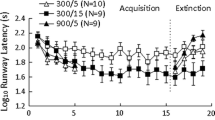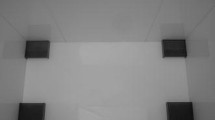Abstract
Prior research with terrestrial toads (Rhinella arenarum) in a water-reinforced instrumental situation indicated a direct relationship between acquisition rate and reward magnitude. However, a reward downshift produced a gradual adjustment of instrumental performance and a rapid adjustment of consummatory performance, rather than the abrupt and transient deterioration of behavior typical of a successive negative contrast effect. In Experiment 1, using a two-chamber box, a downshift from deionized water (which supports maximal rehydration) to 250-mM sodium chloride solution (which supports a lower rehydration), also yielded a gradual adjustment of instrumental behavior. In this experiment, animals received one trial per day and were allowed 300 s of access to the reward in the goal box. Experiment 2 used the same procedure, except that animals were allowed access to the solution in the goal box for 600 s. Under these conditions, reward downshift led to longer latencies (instrumental) and lower rehydration levels (consummatory) than those of unshifted controls, providing evidence for successive negative contrast. Unlike in similar experiments with mammals, the effect was not transient, but persisted relatively unmodified over twelve daily postshift trials. In this case, the possibility of adaptation of the peripheral mechanisms for water uptake is considered. The comparative relevance of these results is discussed in terms of habit formation versus expectancy-guided behavior in vertebrate learning.



Similar content being viewed by others
References
Amsel A (1992) Frustration theory. Cambridge University Press, Cambridge
Bentosela M, Ruetti E, Muzio RN, Mustaca AE, Papini MR (2006) Administration of corticosterone alter the first downshift trial enhances consummatory successive contrast. Behav Neurosci 120(2):371–376. https://doi.org/10.1037/0735-7044.120.2.371
Christensen CU (1974) Adaptation in water economy of some anuran Amphibia. Comp Biochem Physiol 47A:1035–1049
Daneri F, Papini MR, Muzio RN (2007) Common toads (Bufo arenarum) learn to anticipate and avoid hypertonic saline solutions. J Comp Psychol 121(4):419–427. https://doi.org/10.1037/0735-7036.121.4.419
Daniel AM, Ortega LA, Papini MR (2009) Role of the opioid system in incentive downshift situations. Neurobiol Learn Mem 92:439–450. https://doi.org/10.1016/j.nlm.2009.06.003
Di Lollo V, Beez V (1966) Negative contrast effect as a function of magnitude of reward decrement. Psychonomic Sci 5:99–100. https://doi.org/10.3758/BF03328300
Dickinson A (1985) Actions and habits: the development of behavioural autonomy. Philos Trans R Soc Lond B 308:67–78. https://doi.org/10.1098/rstb.1985.0010
Feldon J, Weiner J (1991) Effects of haloperidol on the multitrial partial reinforcement extinction effect (PREE): evidence for neuroleptic drug action on nonreinforcement but not on reinforcement. Psychopharmacology 105:407–414. https://doi.org/10.1007/BF02244437
Feldon J, Katz Y, Weiner J (1988) The effects of haloperidol on the partial reinforcement extinction effect (PREE): implications for neuroleptic drug action on reinforcement and nonreinforcement. Psychopharmacology 95:528–533. https://doi.org/10.1007/BF00172968
Flaherty CF (1996) Incentive relativity. Cambridge University Press, Cambridge
Flaherty CF, Grigson PS, Rowan GA (1986) Chlordiazepoxide and the determinants of contrast. Anim Learn Behav 14:315–321. https://doi.org/10.3758/BF03200073
Hull CL (1943) Principles of behavior. Appleton-Century, Nueva York
IUCN (2014) International union for conservation of nature and natural resources red list of threatened species. Version 2014.3. IUCN, Cambridge
Jiménez-García AM, Ruiz-Leyva L, Cendán CM, Torres C, Papini MR, Morón I (2016) Hypoalgesia induced by reward devaluation in rats. PLoS One 11:1–15. https://doi.org/10.1371/journal.pone.0164331
Kamenetzky GV, Mustaca AE, Papini MR (2008) An analysis of the anxiolytic effects of ethanol on consummatory successive negative contrast. Adv Latin Am Psychol 26:135–144
Katz U (1987) The effect of salt acclimation of the water uptake and osmotic permeability of the skin of the toad (Bufo viridis, L.). J Physiol 82:183–187
Kawasaki K, Glueck AC, Annicchiarico I, Papini MR (2015) Function of the centromedial amygdala in reward devaluation and open-field activity. Neuroscience 303:73–81. https://doi.org/10.1016/j.neuroscience.2015.06.053
Kawasaki K, Annicchiarico I, Glueck AC, Moron I, Papini MR (2017) Reward loss and the basolateral amygdala: a function in reward comparisons. Behav Brain Res 331:205–213. https://doi.org/10.1016/j.bbr.2017.05.036
Liao RM, Chuang FJ (2003) Differential effects of diazepam infused into the amygdala and hippocampus on negative contrast. Pharmacol Biochem Behav 74:953–960. https://doi.org/10.1016/S0091-3057(03)00023-6
Lin J, Roman C, Reilly S (2009) Insular cortex and consummatory successive negative contrast in the rat. Behav Neurosci 123:810–814. https://doi.org/10.1037/a0016460
Loza Coll MA, Muzio RN (in preparation) Hypertonic NaCl solutions as aversive stimuli in terrestrial toads
Mustaca AE and Papini MR (2005) Consummatory successive negative contrast induces hypoalgesia. Int J Compar Psycholo 18:255–262. https://escholarship.org/uc/item/0wk482rp
Muzio RN, Segura ET, Papini MR (1992) Effect of schedule and magnitude of reinforcement on instrumental acquisition and extinction in the toad, Bufo arenarum. Learn Motiv 23:406–429. https://doi.org/10.1016/0023-9690(92)90004-6
Muzio RN, Pistone Creydt V, Iurman M, Rinaldi M, Sirani B, Papini MR (2011) Incentive or habit learning in amphibians? PLoS ONE 6(11):e25798. https://doi.org/10.1371/journal.pone.0025798 (1–12)
National Research Council (2011) Guide for the care and use of laboratory animals, 8th edn. National Academies Press, Washington
Ortega LA, Uhelski M, Fuchs PN, Papini MR (2011) Impairment of recovery from incentive downshift after lesions of the anterior cingulate cortex: Emotional or cognitive deficits? Behav Neurosci 125:988–995. https://doi.org/10.1037/a0025769
Ortega LA, Glueck AC, Uhelski M, Fuchs PN, Papini MR (2013) Role of the ventrolateral orbital cortex and medial prefrontal cortx in incentive downshift situations. Behav Brain Res 244:120–129. https://doi.org/10.1016/j.bbr.2013.01.029
Ortega LA, Solano JL, Torres C, Papini MR (2017) Reward loss and addiction: opportunities for cross-pollination. Pharmacol Biochem Behav 154:39–52. https://doi.org/10.1016/j.pbb.2017.02.001
Papini MR (2003) Comparative psychology of surprising nonreward. Brain Behav Evol 62:83–95. https://doi.org/10.1159/000072439
Papini MR, Pellegrini S (2006) Scaling relative incentive value in consummatory behavior. Learn Motiv 37:357–378. https://doi.org/10.1016/j.lmot.2006.01.001
Papini MR, Muzio RN, Segura ET (1995) Instrumental learning in toads (Bufo arenarum): reinforcer magnitude and the medial pallium. Brain Behav Evol 46:61–71. https://doi.org/10.1159/000113259
Papini MR (2014) Diversity of adjustments to reward downshift in vertebrates. Int J Compar Psychol 27:420–445. https://escholarship.org/uc/item/4db381nz
Papini S, Galatzer-Levy IR, Papini MR (2014) Identifying profiles of recovery from reward devaluation in rats. Behav Brain Res 275:212–218. https://doi.org/10.1016/j.bbr.2014.09.006
Papini MR, Fuchs PN, Torres C (2015) Behavioral neuroscience of psychological pain. Neurosci Biobehav Rev 48:53–69. https://doi.org/10.1016/j.neubiorev.2014.11.012
Pecoraro N, Ginsberg AB, Akana SF, Dallman MF (2007) Temperature and activity responses to sucrose concentration reductions occur on the 1st but not the 2nd day of concentration shifts, and are blocked by low, constant glucocorticoids. Behav Neurosci 121:764–778. https://doi.org/10.1037/0735-7044.121.4.764
Pecoraro N, de Jong H, Dallman MF (2009) An unexpected reduction in sucrose concentration activates the HPA axis on successive post shift days without attenuation by discriminative contextual stimuli. Physiol Behav 96:651–661. https://doi.org/10.1016/j.physbeh.2008.12.018
Puddington MM, Daneri MF, Papini MR, Muzio RN (2016) Telencephalic neural activation after passive avoidance learning in the terrestrial toad Rhinella arenarum. Behav Brain Res 315:75–82. https://doi.org/10.1016/j.bbr.2016.08.003
Reboreda JC, Muzio RN, Viñas MC, Segura ET (1991) β-adrenergic control of the water permeability of the skin during rehydration in the toad Bufo arenarum. Comp Biochem Physiol 100C:433–437
Rescorla RA, Wagner AR (1972) A theory of Pavlovian conditioning: variations in the effectiveness of reinforcement and nonreinforcement. In: Black AH, Prokasy WF (eds) Classical conditioning II: current research and theory. Appleton, New York, pp 64–99
Ruetti E, Justel N, Mustaca AE, Papini MR (2009) Postsession corticosterone administration enhances the effects of incentive downshift: exploring the boundaries of this effect. Behav Neurosci 123:127–144. https://doi.org/10.1037/a0013805
Ruibal R (1962) The adaptive value of bladder water in the toad (Bufo cognatus). Physiol Zool 35:218–223. https://doi.org/10.1086/physzool.35.3.30152806
Sastre A, Lin J-Y and Reilly S (2005) Failure to obtain instrumental successive negative contrast in tasks that support consummatory successive negative contrast. Int J Compar Psychol 18:307–319. https://escholarship.org/uc/item/8r04f6hc
Schmajuk N, Segura ET (1982) Behavioural regulation of water balance in the toad Bufo arenarum. Herpetologica 38:296–301
Suzuki M, Tanaka S (2009) Molecular and cellular regulation of water homeostasis in anuran amphibians by aquaporins. Compar Biochem Physiol A 153:231–241
Suzuki M, Hasegawa T, Ogushi Y, Tanaka S (2007) Amphibian aquaporins and adaptation to terrestrial environments: a review. Compar Biochem Physiol A 148:72–81
Thomas BL, Papini MR (2003) Mechanisms of spaced-trial runway extinction in pigeons. Learn Motiv 34:104–126. https://doi.org/10.1016/S0023-9690(02)00506-4
Titon B Jr, Navas CA, Jim J, Gomes FR (2010) Water balance and locomotor performance in threespecies of neotropical toads that differ in geographical distribution. Compar Biochem Physiol A 156:129–135
Funding
This research was funded in part by Grant PICT 4300 (FONCYT), by Grant PIP 0893 (CONICET), and by Grant UBACYT P0068BA (Universidad de Buenos Aires), Argentina, all to RNM. Animal procedures were authorized under Institutional Animal Care and Use Committee (IACUC) protocol 035/2016 IBYME-CONICET, Argentina.
Author information
Authors and Affiliations
Corresponding author
Additional information
Publisher's Note
Springer Nature remains neutral with regard to jurisdictional claims in published maps and institutional affiliations.
Rights and permissions
About this article
Cite this article
Muzio, R.N., Yohena, A. & Papini, M.R. Evidence of successive negative contrast in terrestrial toads (Rhinella arenarum): central or peripheral effect?. Anim Cogn 25, 1453–1460 (2022). https://doi.org/10.1007/s10071-022-01626-4
Received:
Revised:
Accepted:
Published:
Issue Date:
DOI: https://doi.org/10.1007/s10071-022-01626-4




